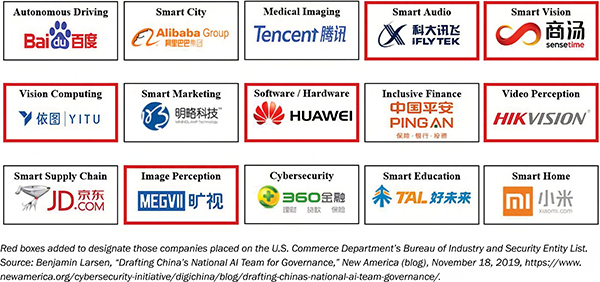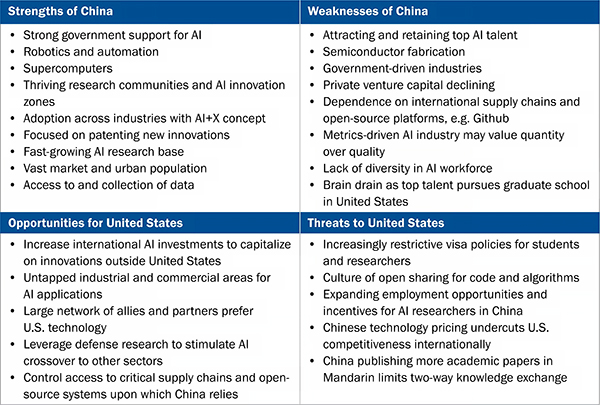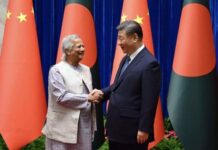READ ALSO: China’s Next-Gen Artificial Intelligence Development Plan (Part 2)
Introduction
On July 20, China’s State Council issued a seminal document, entitled “A Next Generation Artificial Intelligence Development Plan.” This important aspirational document sets out a top-level design blueprint charting the country’s approach to developing artificial intelligence (AI) technology and applications, setting broad goals up to 2030. This is a translated extract.
The rapid development of artificial intelligence (AI) will profoundly change human society and life and change the world. To seize the major strategic opportunity for the development of AI, to build China’s first-mover advantage in the development of AI, to accelerate the construction of an innovative nation and global power in science and technology, in accordance with the requirements of the CCP Central Committee and the State Council, this plan has been formulated.
I. The Strategic Situation
The development of AI has entered a new stage. After sixty years of evolution, especially in mobile Internet, big data, supercomputing, sensor networks, brain science, and other new theories and new technologies, under the joint impetus of powerful demands of economic and social development, AI’s development has accelerated, displaying deep learning, cross-domain integration, man-machine collaboration, the opening of swarm intelligence, autonomous control, and other new characteristics. Big data-driven cognitive learning, cross-media collaborative processing, and man-machine collaboration-strengthened intelligence, swarm integrated intelligence, and autonomous intelligent systems have become the focus of the development of AI. The results of brain science research inspired human-like intelligence that awaits action; the trends involving the chips, hardware, and platform have become apparent; the development of AI has entered into a new stage. At present, the development a new generation of AI and related disciplines, theoretical modeling, technological innovation, hardware and software upgrades, etc., all advance, provoking chain-style breakthroughs, promoting the acceleration of the elevation of economic and social domains from digitization and networkization to intelligentization.
AI has become a new focus of international competition. AI is a strategic technology that will lead in the future; the world’s major developed countries are taking the development of AI as a major strategy to enhance national competitiveness and protect national security; intensifying the introduction of plans and strategies for this core technology, top talent, standards and regulations, etc.; and trying to seize the initiative in the new round of international science and technology competition. At present, China’s situation in national security and international competition is more complex, and [China] must, looking at the world, take the development of AI to the national strategic level with systemic layout, take the initiative in planning, firmly seize the strategic initiative in the new stage of international competition in AI development, to create new competitive advantage, opening up the development of new space, and effectively protecting national security.
AI has become a new engine of economic development. AI has become the core driving force for a new round of industrial transformation, [which] will advance the release of the huge energy stored from the previous scientific and technological revolution and industrial transformation, and create a new powerful engine, reconstructing production, distribution, exchange, consumption, etc., links in economic activities; with new demands taking shape from the macro to the micro within each domain of intelligentization; with the birth of new technologies, new products, new industries, new formats, new models; triggering significant changes in economic structure, profound changes in human modes of production, lifestyle, and thinking; and a whole leap of achieving social productivity.
AI brings new opportunities for social construction. China is currently in the decisive stage of comprehensively constructing a moderately prosperous society. The challenges of population aging, environmental constraints, etc., remain serious. The widespread use of AI in education, medical care, pensions, environmental protection, urban operations, judicial services, and other fields will greatly improve the level of precision in public services, comprehensively enhancing the people’s quality of life. AI technologies can accurately sense, forecast, and provide early warning of major situations for infrastructure facilities and social security operations; grasp group cognition and psychological changes in a timely manner; and take the initiative in decision-making and reactions-which will significantly elevate the capability and level of social governance, playing an irreplaceable role in effectively maintaining social stability.
The uncertainties in the development of AI create new challenges. AI is a disruptive technology with widespread influence that may cause: transformation of employment structures; impact on legal and social theories; violations of personal privacy; challenges in international relations and norms; and other problems. It will have far-reaching effects on the management of government, economic security, and social stability, as well as global governance. While vigorously developing AI, we must attach great importance to the potential safety risks and challenges, strengthen the forward-looking prevention and guidance on restraint, minimize risk, and ensure the safe, reliable, and controllable development of AI.
China possesses a favorable foundation for the development of AI. The nation has: deployed the National Key Research and Development Plan’s key special projects, such as intelligent manufacturing; issued and implemented the “Internet +” and AI Three-Year Activities and Implementation Program, releasing a series of measures from science and technology research and development; and promoted applications and industrial development, and other aspects. As a result of many years of continuous accumulation, China has achieved important progress in the field of AI, with the number of international scientific and technology papers published and the number of inventions patented ranked second in the world, while achieving important breakthroughs in certain domains of core crucial technologies. Leading the world in voice recognition and visual recognition technologies; initially possessing the capability for leapfrog development in adaptive autonomous learning, intuitive sensing, comprehensive reasoning, hybrid intelligence, and swarm intelligence, etc.; with Chinese information processing, intelligent monitoring, biometric identification, industrial robots, service robots, and unmanned driving gradually entering practical application; AI innovation and entrepreneurship have become increasingly active, and a number of leading enterprises have accelerated their growth, receiving widespread concern and recognition internationally. Accelerate the accumulation of technological capabilities and massive data resources, the organization integration of both the huge demand for applications and an open market environment, which together constitute China’s unique advantage in AI development.
At the same time, we must also clearly see that there is still a gap between China’s overall level of development of AI relative to that of developed countries-lacking major original results in the basic theory, core algorithms, key equipment, high-end chips, major products and systems, foundational materials, components, software and interfaces, etc. Scientific research institutions and enterprises do not yet possess international influence upon ecological cycles and supply chain, lacking a systematic research and development layout; cutting-edge talent for AI is far from meeting demand. Adapting to the development of AI requires the urgent improvement of basic infrastructure, policies and regulations, and standards systems.
Facing a new situation and new demands, we must take the initiative to pursue and adapt to change, firmly seize the major historic opportunity for the development of AI, stick closely to development, study and evaluate the general trends, take the initiative to plan, grasp the direction, seize the opportunity, lead the world in new trends in the development of AI, serve economic and social development, and support national security, promoting the overall elevation of the nation’s competitiveness and leapfrog development.
II. The Overall Requirements
(1) The Basic Principles
Technology-Led. Grasp the global development trend of AI, highlight the deployment of forward-looking research and development, explore the layout in key frontier domains, long-term support, and strive to achieve transformational and disruptive breakthroughs in theory, methods, tools, and systems; comprehensively enhance original innovation capability in AI, accelerate the construction of a first-mover advantage, to achieve high- end leading development.
Systems Layout. According to the different characteristics of foundational research, technological research and development, industrial development, and commercial applications, formulate a targeted systems development strategy. Fully give play to the advantages of the socialist system to concentrate forces to do major undertakings, promote the planning and layout of projects, bases, and a talent pool, organically link already-deployed major projects and new missions, continue current urgent needs and long-term development echelons, construct innovation capacity, create a collaborative force for institutional reforms and the policy environment.
Market-Dominant. Follow the rules of the market, remain oriented toward application, highlight companies’ choices on the technological line and primary role in the development of commercial product standards, accelerate the commercialization of AI technology and results, and create a competitive advantage. Grasp well the division of labor between government and the market, better take advantage of the government in planning and guidance, policy support, security and guarding, market regulation, environmental construction, the formulation of ethical regulations, etc.
Open-Source and Open. Advocate the concept of open-source sharing, and promote the concept of industry, academia, research, and production units each innovating and in principal pursuing joint innovation and sharing. Follow the coordinated development law for economic and national defense construction; promote two-way conversion and application for military and civilian scientific and technological achievements and co-construction and sharing of military and civilian innovation resources; form an all-element, multi-domain, highly efficient new pattern of civil-military integration. Actively participate in global research and development and management of AI, and optimize the allocation of innovative resources on a global scale.
(2) Strategic Objectives
These are divided into the following three steps:
First, by 2020, the overall technology and application of AI will be in step with globally advanced levels, the AI industry will have become a new important economic growth point, and AI technology applications will have become a new way to improve people’s livelihoods, strongly supporting [China’s] entrance into the ranks of innovative nations and comprehensively achieving the struggle toward the goal of a moderately prosperous society.
—By 2020 China will have achieved important progress in a new generation of AI theories and technologies. It will have actualized important progress in big data intelligence, cross-medium intelligence, swarm intelligence, hybrid enhanced intelligence, and autonomous intelligence systems, and will have achieved important progress in other foundational theories and core technologies; the country will have achieved iconic advances in AI models and methods, core devices, high-end equipment, and foundational software.
—The AI industry’s competitiveness will have entered the first echelon internationally. China will have established initial AI technology standards, service systems, and industrial ecological system chains. It will have cultivated a number of the world’s leading AI backbone enterprises, with the scale of AI’s core industry exceeding 150 billion RMB, and exceeding 1 trillion RMB as driven by the scale of related industries.
—The AI development environment will be further optimized, opening up new applications in important domains, gathering a number of high-level personnel and innovation teams, and initially establishing AI ethical norms, policies, and regulations in some areas.
Second, by 2025, China will achieve major breakthroughs in basic theories for AI, such that some technologies and applications achieve a world-leading level and AI becomes the main driving force for China’s industrial upgrading and economic transformation.
—By 2025, a new generation of AI theory and technology system will be initially established, as AI with autonomous learning ability achieves breakthroughs in many areas to obtain leading research results.
—The AI industry will enter into the global high-end value chain. This new-generation AI will be widely used in intelligent manufacturing, intelligent medicine, intelligent city, intelligent agriculture, national defense construction, and other fields, while the scale of AI’s core industry will be more than 400 billion RMB, and the scale of related industries will exceed 5 trillion RMB.
—By 2025 China will have seen the initial establishment of AI laws and regulations, ethical norms and policy systems, and the formation of AI security assessment and control capabilities.
Third, by 2030, China’s AI theories, technologies, and applications should achieve world- leading levels, making China the world’s primary AI innovation center, achieving visible results in intelligent economy and intelligent society applications, and laying an important foundation for becoming a leading innovation-style nation and an economic power.
—China will have formed a more mature new-generation AI theory and technology system. The country will achieve major breakthroughs in brain-inspired intelligence, autonomous intelligence, hybrid intelligence, swarm intelligence, and other areas, having important impact in the domain of international AI research and occupying the commanding heights of AI technology.
—AI industry competitiveness will reach the world-leading level. AI should be expansively deepened and greatly expanded into production and livelihood, social governance, national defense construction, and in all aspects of applications, will become an expansive core technology for key systems, support platforms, and the intelligent application of a complete industrial chain and high-end industrial clusters, with AI core industry scale exceeding 1 trillion RMB, and with the scale of related industries exceeding 10 trillion RMB.
—China will have established a number of world-leading AI technology innovation and personnel training centers (or bases), and will have constructed more comprehensive AI laws and regulations, and an ethical norms and policy system.
(3) Overall Deployment
The development of AI is a complex systemic project related to the overall situation, that must be arranged in accordance with “build one system, grasp the two attributes, adhere to the trinity, and strengthen the four supports” to form a strategic path for the healthy and sustainable development of AI.
Construct an open and cooperative AI technology innovation system. Target the weak foundation in original theories, and the key difficulties and deficiencies in major products and systems. Establish foundational theories and a common technology system for a new generation of AI, laying out the construction of a major scientific and technological innovation base. Strengthen the high-end talent team in AI to promote innovation and cooperative interactions. Form a continuous innovation capability for AI.
Grasp AI’s characteristic high degree of integration of technological attributes and social attributes. It is necessary not only to increase efforts in the research and development and applications of AI, maximizing the potential of AI, but also to predict AI’s challenges, coordinate industrial policies, innovate in policies and social policies, achieve the coordination of encouraging development and reasonable regulation, and maximize risk prevention.
Adhere to the promotion of the trinity of breakthroughs in AI research and development, product applications, and fostering industry development. Adapt to the characteristics and trends of AI development. Strengthen the deep integration of the innovation chain and industrial chain, the interactive evolution of technology supply and market demand. Take technological breakthroughs to promote domain applications and industrial upgrading.
Through application demonstrations, promote the optimization of technologies and systems. At the same time as greatly promoting technology applications and industrial development, strengthen long-term R&D layout and research. Achieve rolling development and continuous improvement. Ensure that theory is in the front, the technological commanding heights are occupied, and applications are secure and controllable.
Fully support science and technology, the economy, social development, and national security. Drive comprehensive elevation on national innovative capability with AI technological breakthroughs. Lead in the process of constructing a global science and technology power. Through strengthening intelligent industry and cultivating the intelligent economy, create a new growth cycle for China’s next decade or even decades of economic prosperity. Through building an intelligent society, promote the improvement of people’s livelihoods and welfare and implement people-centric development thinking. Through AI, elevate national defense strength and assure and protect national security.
READ ALSO: China’s Next-Gen Artificial Intelligence Development Plan (Part 2)



















